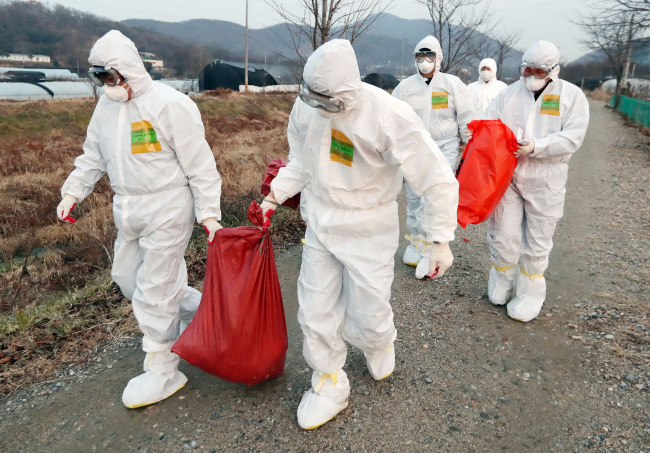With at least 70,000 people involved in the mass culling of poultry at bird flu-hit areas recently, concerns of human infections of the virus are rising due to the workers‘ exposure, a lawmaker said Tuesday.
“Since workers participating in culling and burying infected poultry in rural areas are directly exposed to the virus, they carry a higher likelihood of getting infected,” said main opposition Democratic Party of Korea Rep. Kim Hyun-kwon, adding the government should come up with stricter quarantine measures.
According to the Ministry of Agriculture, Food and Rural Affairs, at least 3,400 public officials and 19,000 civilians were put into work to cull and bury infected poultry at 42 sites across the nation, over the past 40 days since the virus was first detected in South Chungcheong Province.
 |
Researchers collect bird flu-infected poultry at a farm located in Incheon on Monday. (Yonhap) |
There have been no reports of infections through people or livestock thus far.
While local governments are mainly responsible for dispatching people to work at infected poultry farms, military officials said Tuesday they have been sending the Army’s Chemical Forces to affected areas in South Gyeongsang Province and North Jeolla Province since last week, due to a shortage of workers.
The Korea Centers for Disease Control and Prevention said last week that the government classified some 13,000 workers at the disease-hit sites as a high-risk group to receive state monitoring, and helped them get vaccinations.
Quarantine authorities added that they also provided workers antiviral drugs like Tamiflu and protective clothing to guard against the outbreak spreading to people.
But the highly pathogenic bird flu is spreading at an unprecedented pace across the country, having already swept through neighboring countries earlier this year, killing over 20 people.
In China, there have been 16 H5N6 human infections since 2014, resulting in the deaths of 10 of those infected.
So far, authorities said 26 people among the high-risk group reported flu-like symptoms, but none of them have been confirmed to have the virus.
The highly pathogenic H5N6 strain of bird flu is currently being examined at the National Institute of Environmental Research to find out if the outbreak can spread to people, authorities added.
The current outbreak is already worse than that in 2014, when 13.96 million fowls were put down over six months.
A record number of 10 million chickens, ducks and quails have been culled throughout the nation so far, with an additional 3.78 million in waiting.
By Kim Da-sol(
ddd@heraldcorp.com)








![[Today’s K-pop] Blackpink’s Jennie, Lisa invited to Coachella as solo acts](http://res.heraldm.com/phpwas/restmb_idxmake.php?idx=644&simg=/content/image/2024/11/21/20241121050099_0.jpg)